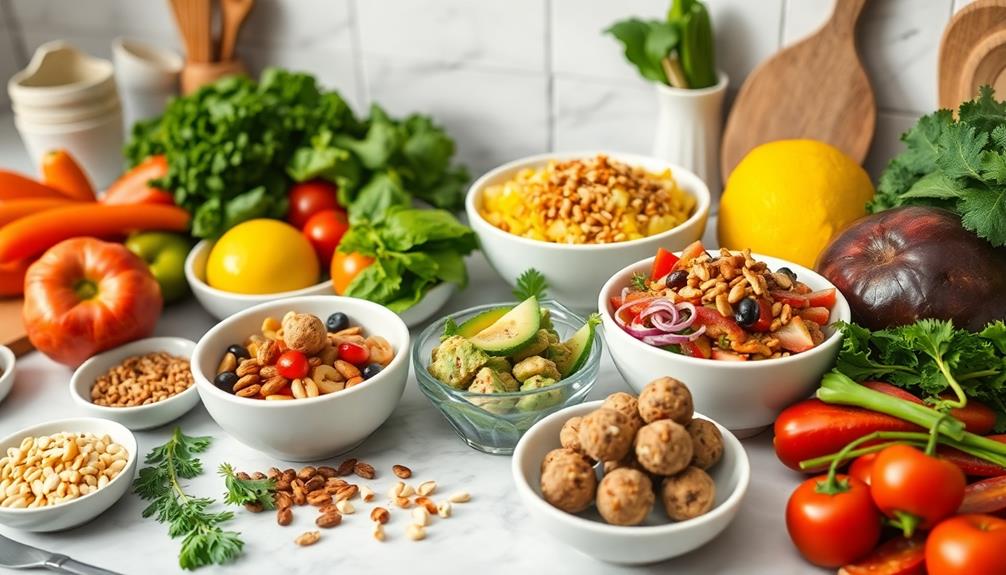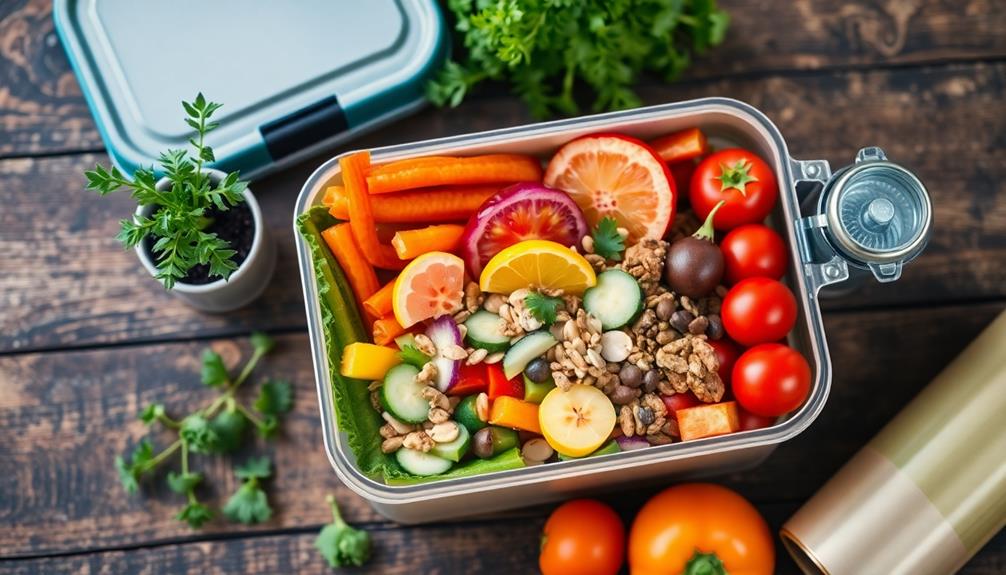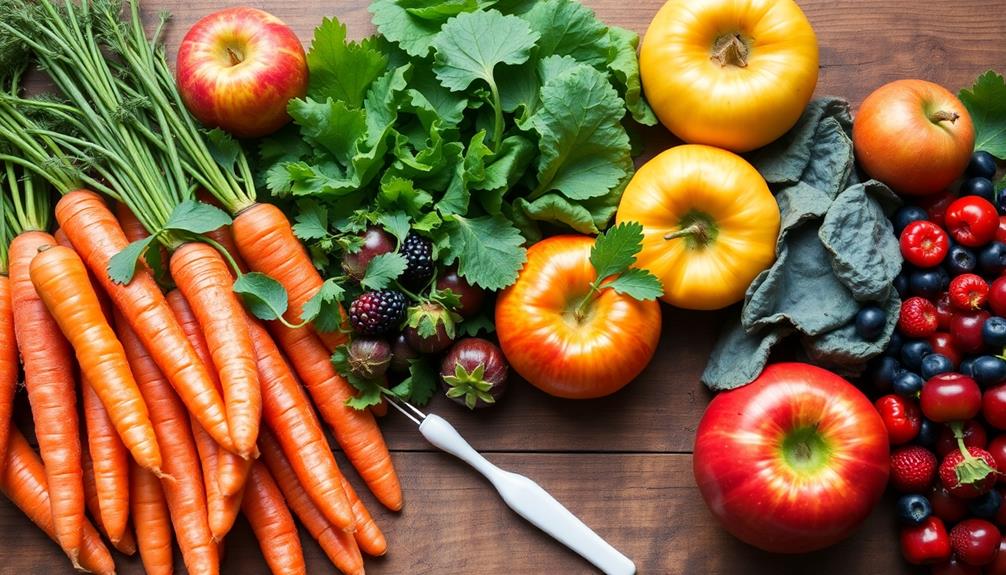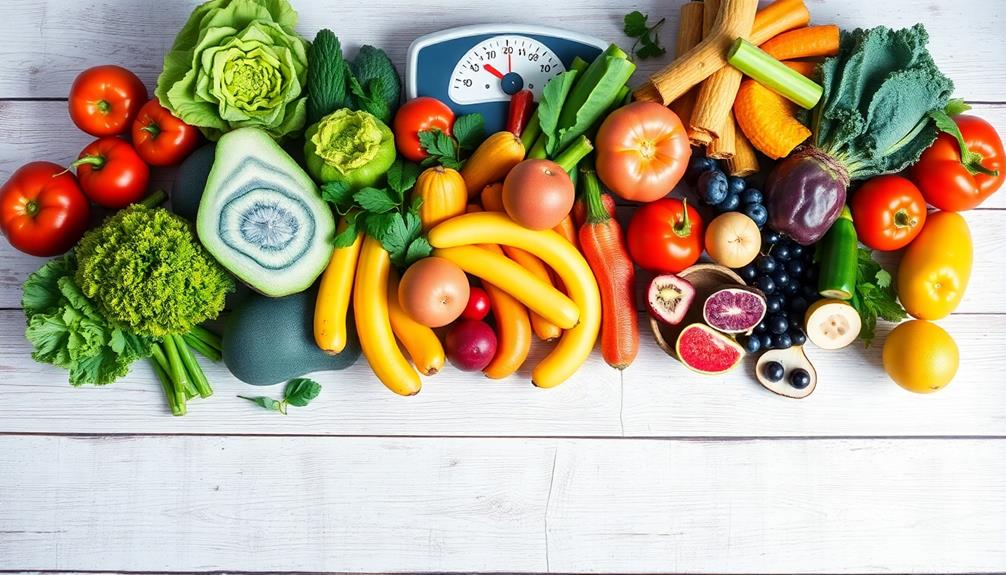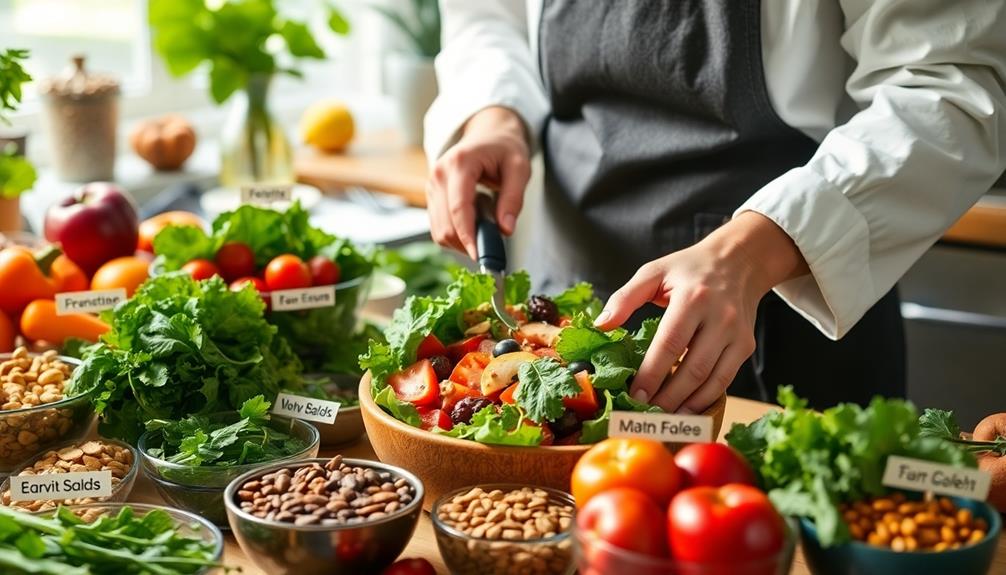Raw food meal prep makes healthy eating a breeze for your week ahead. With recipes that take only 10 minutes to prepare, you'll enjoy dishes like zucchini noodles with avocado sauce and chickpea salad. Stock your pantry with leafy greens, fresh fruits, and nuts for easy access. Most meals store well in air-tight containers for 3 to 7 days, preserving their fresh taste. These recipes not only offer vibrant flavors but also provide significant nutritional benefits. Ready to explore more delicious options and tips for successful meal prep? There's plenty waiting for you just around the corner!
Key Takeaways
- Plan a week's worth of meals by selecting 7 easy raw vegan recipes that can be prepared in around 10 minutes each.
- Stock your pantry with essential ingredients like leafy greens, fresh fruits, nuts, seeds, and seasonal vegetables for variety and nutrition.
- Utilize air-tight containers to store prepared meals, ensuring they remain fresh for 3-7 days and minimize food waste.
- Rotate meals throughout the week to maintain variety in flavors and textures while keeping your diet interesting.
- Engage with a community for support, recipe ideas, and tips to enhance your raw food meal prep experience.
Overview of Raw Vegan Meal Prep
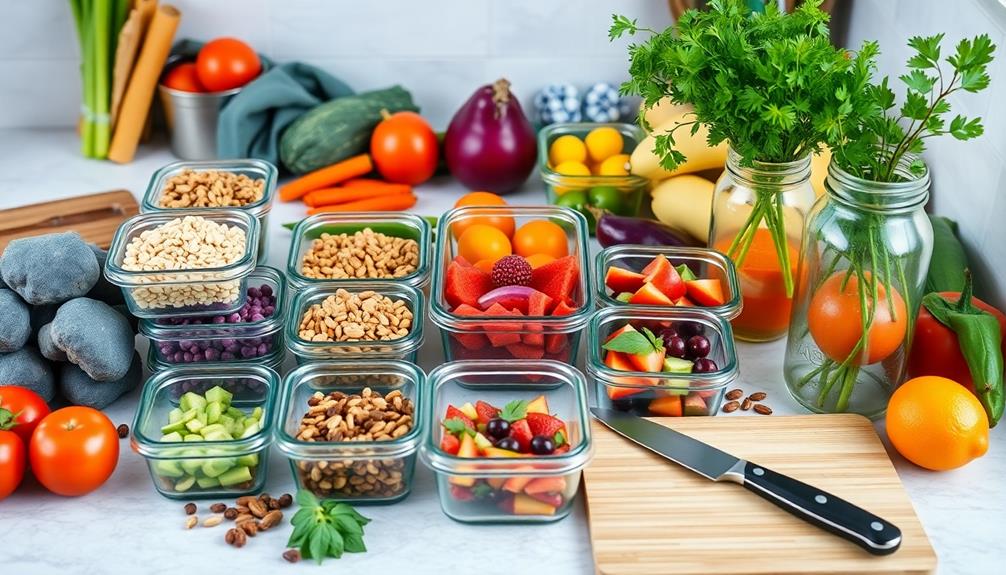
Raw vegan meal prep is all about embracing fresh, whole ingredients to create delicious dishes in no time. With an average prep time of just 10 minutes per recipe, you can whip up a nutritious raw vegan meal even in the busiest of schedules.
The beauty of this approach lies in its emphasis on using healthy ingredients that not only nourish your body but also tantalize your taste buds.
You'll find that most raw vegan meals can be stored in air-tight containers in the refrigerator for 2-7 days, keeping your meals fresh and minimizing food waste. Imagine having a diverse selection of 30 raw vegan recipes at your fingertips, from vibrant salads to satisfying dips and spreads, allowing you to enjoy creative meal planning throughout the week.
Each serving generally contains around 350 calories, promoting nutritional balance while keeping your energy levels up. Plus, by incorporating seasonal ingredients, you enhance flavors while supporting local farmers and sustainability.
Whether you're preparing a quick snack or a full meal, raw vegan meal prep makes healthy eating both accessible and enjoyable. You'll love the variety and convenience it brings to your lifestyle!
Easy Raw Vegan Recipes
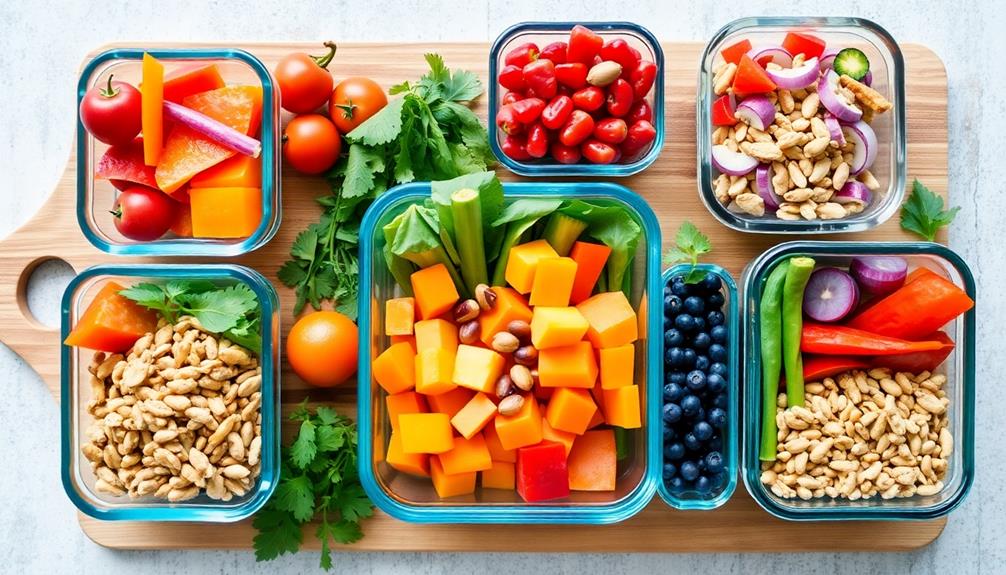
Discovering easy raw vegan recipes can transform your meal prep routine into a delightful experience. These simple raw recipes take only about 10 minutes to prepare, making them perfect for your busy lifestyle while promoting a healthy raw food diet.
Incorporating more raw foods into your meals can lead to improved digestion and increased energy levels, essential for maintaining a hectic schedule. With each serving around 350 calories, you can enjoy balanced meals that keep you energized throughout the day and provide potential weight loss benefits.
Here's a quick list of easy raw vegan recipes you can try:
- Zucchini Noodles with Avocado Sauce: A fresh twist on pasta that's creamy and satisfying.
- Chickpea Salad: Packed with protein and vibrant veggies, it's a filling option for lunch.
- Raw Chocolate Energy Bites: A sweet treat to curb your cravings without the guilt.
Essential Ingredients for Prep
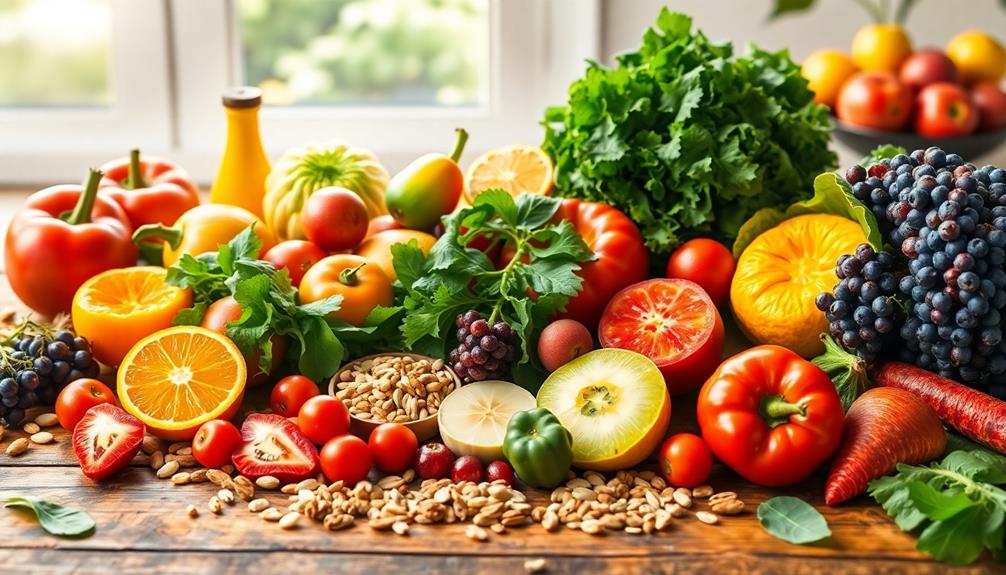
To make the most of your easy raw vegan recipes, it's important to have the right ingredients on hand. Start by stocking your kitchen with staple items like leafy greens, fresh fruits, nuts, seeds, and a variety of vegetables. These essentials will guarantee you can whip up a range of dishes that align with your raw vegan diet.
Incorporating seasonal produce not only boosts flavor but also enhances the nutritional value of your meals, as many nutrients are preserved in their raw state, leading to potential benefits of raw food such as improved digestion and increased energy levels. Consider versatile ingredients like avocados, which can add creaminess and healthy fats to salads, dressings, and desserts.
Keeping raw pantry essentials like chia seeds, flaxseeds, and nut butters will also provide quick snacks and elevate your meal's nutritional profile. Don't forget to have almond milk on hand, as it's great for smoothies and creamy soups.
A good food processor is invaluable for creating dips, dressings, and even desserts, making meal prep easier and more enjoyable. Finally, experiment with fresh herbs and spices to elevate the flavors of your raw dishes, turning each meal into an exciting culinary experience.
Meal Storage and Shelf Life
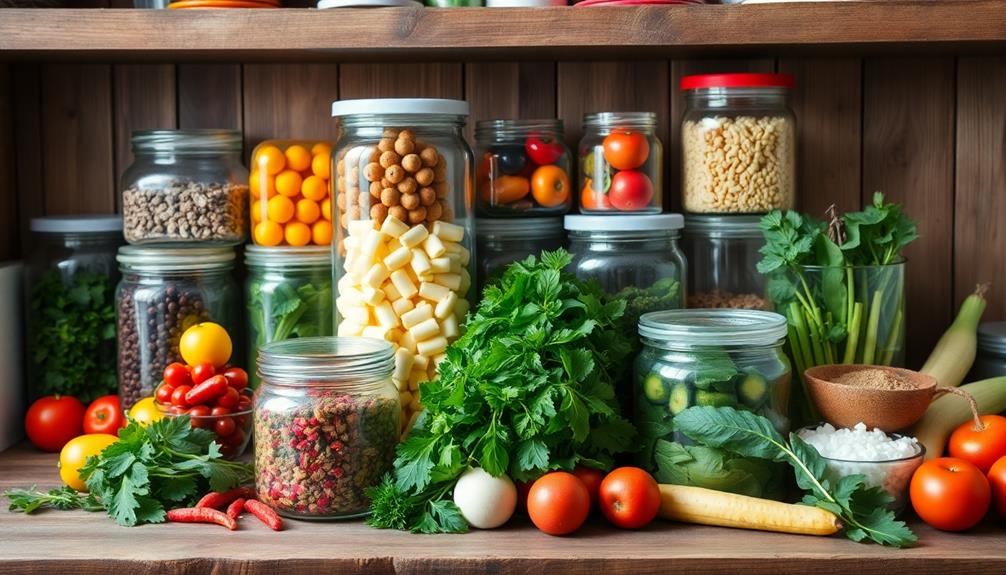
To keep your raw meals fresh, it's essential to use proper storage techniques, like air-tight containers that limit airflow.
You'll find that most recipes last between 3 to 7 days, so planning your meals and rotating recipes will help you maintain variety while minimizing waste.
Plus, for longer-lasting ingredients like date paste, freezing can extend their shelf life for months.
Proper Storage Techniques
Proper storage techniques are essential for maximizing the freshness and flavor of your raw food meal prep.
When you store your meals properly, you can enjoy them at their best for up to 7 days. Here are some key tips to help you keep your meals fresh:
- Use air-tight containers to limit airflow and prevent spoilage.
- Keep your meals in the refrigerator at a consistent temperature for ideal freshness.
- Rotate your meals throughout the week to reduce waste and maintain variety.
Ideal Shelf Life
Understanding the ideal shelf life of your raw food meals is vital for enjoying them at their best. Most raw and vegan recipes can last between 3 to 7 days when stored properly in air-tight containers. This practice helps maintain freshness, allowing you to savor your meal prep creations longer.
For versatile options, consider dips and spreads like smoked paprika and sun-dried tomato hummus, which can last 4 to 7 days. If you like adding something sweet, fruit preserves such as blueberry mint chia jam are perfect, with a shelf life of 1 to 2 weeks.
Proper refrigeration plays an important role in extending the shelf life of your prepared raw meals. Most dishes taste best on the day they're made, but with careful storage, you can enjoy them for several days.
Also, some items, like date paste, can be frozen, giving you an extended shelf life of several months. This not only saves you time but also offers convenience for future raw and vegan meal prep.
Keep these tips in mind to guarantee your meals stay fresh and enjoyable!
Meal Prepping Strategies
When it comes to meal prepping raw foods, knowing how to store your creations effectively is key to maximizing their shelf life and freshness. Most raw vegan recipes last 3-7 days when stored in air-tight containers, so proper refrigeration is crucial.
Additionally, ingredients like aloe vera juice can be a great addition to your meals, offering hydration and digestive benefits. Here are some meal prepping strategies to help you keep your meals vibrant and safe to eat:
- Use air-tight containers: This minimizes spoilage and keeps your meals fresh longer.
- Plan for dips and spreads: These can often last up to a week, making them a great addition to your meal prep.
- Freeze certain ingredients: Items like date paste can be frozen for months, reducing food waste.
Additionally, soaking nuts and seeds before use enhances their texture and digestibility, making your meals even more enjoyable.
Nutritional Benefits of Raw Foods
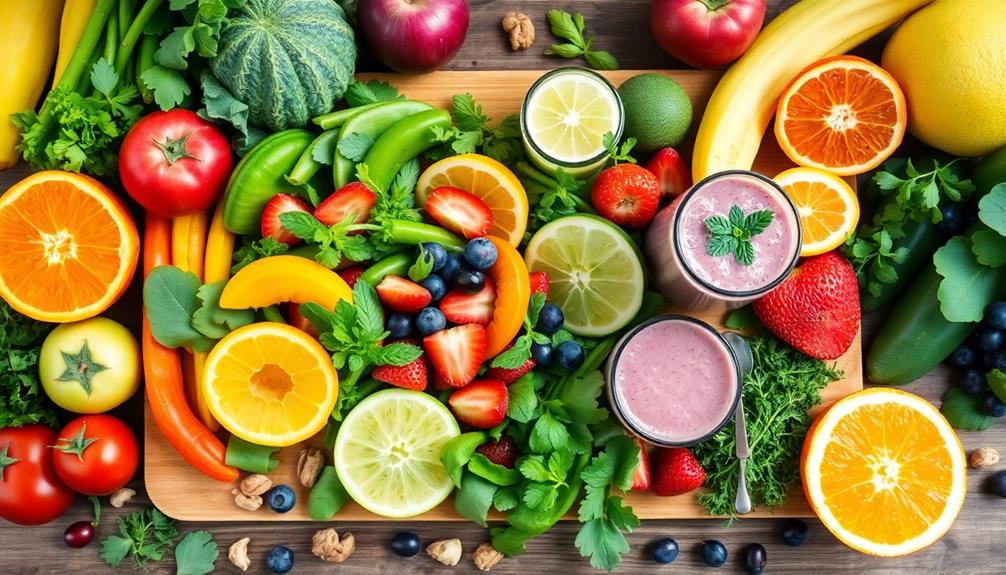
Raw foods pack a powerful punch when it comes to nutritional benefits, making them an excellent choice for anyone looking to enhance their health. These foods are rich in vitamins, minerals, and enzymes, which cooking often diminishes. By consuming raw nutrition, you guarantee higher nutrient retention, leading to better overall health.
A raw vegan diet is typically high in fiber, which aids digestion and promotes gut health by supporting beneficial gut bacteria. You'll likely notice increased energy levels from the natural sugars in raw fruits and vegetables, while their low calorie density can help you reach your weight loss goals.
Choosing raw foods also means avoiding processed ingredients, which can greatly reduce your risk of chronic diseases like heart disease and diabetes. The antioxidants found in raw foods combat oxidative stress in your body, potentially reducing inflammation and improving overall wellness.
Incorporating more raw foods into your diet can lead to a healthier lifestyle. With their impressive health benefits, it's clear that embracing raw nutrition is a smart choice for anyone aiming for peak health.
Tips for Successful Meal Prep
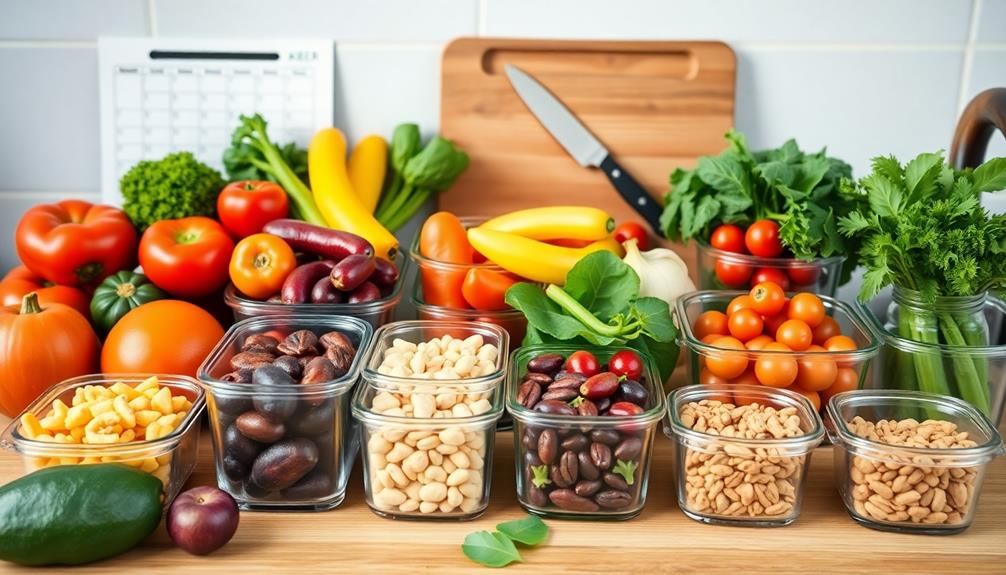
Meal prepping can streamline your week and make eating healthy much easier. To set yourself up for success, start by planning your meals for the week. Create a shopping list to guarantee you have all the fresh ingredients on hand for your raw recipes, which require minimal prep time—about 10 minutes per dish.
Here are some key tips for effective meal prep:
- Use air-tight containers: Store your prepared meals in air-tight containers to maintain freshness and prevent spoilage. They can last between 3-7 days in the fridge.
- Soak nuts and seeds: Enhance the texture and digestibility of your meals by soaking nuts and seeds before use. They make delicious additions to your raw recipes.
- Rotate your recipes: To guarantee a balanced diet and avoid monotony, rotate your recipes throughout the week. This way, you can incorporate a diverse range of flavors and nutrients.
Consider pre-portioning snacks like raw energy bars and vegetable dips in mason jars for quick access during your busy days.
With these tips, you'll make meal prep a breeze while enjoying a nutritious week ahead!
Community and User Experiences

The vibrant community surrounding raw food meal prep thrives on shared experiences and valuable feedback. You'll find that community engagement is essential, as users frequently exchange tips and personal stories about their raw food diets. Many express gratitude for the clarity and organization of recipes, which boosts their confidence in the kitchen.
Here's a glimpse of how community members engage and share their experiences:
| User Feedback | Recipe Adaptations | Health Benefits |
|---|---|---|
| "These recipes are so easy to follow!" | "I swapped mangoes for peaches!" | "I feel more energized daily!" |
| "Loved the fresh flavors!" | "Added nuts for extra protein." | "My digestion has improved!" |
| "Can't believe how simple this is!" | "Used spinach instead of kale." | "I've lost weight and feel great!" |
| "The support here is amazing!" | "Made it raw vegan for a challenge!" | "I've never felt better!" |
Testimonials often highlight the positive impact of raw food diets, encouraging others to join in. With e-books and newsletters at your fingertips, you'll have ongoing support and endless recipe adaptations to explore.
Engaging With Raw Food Recipes
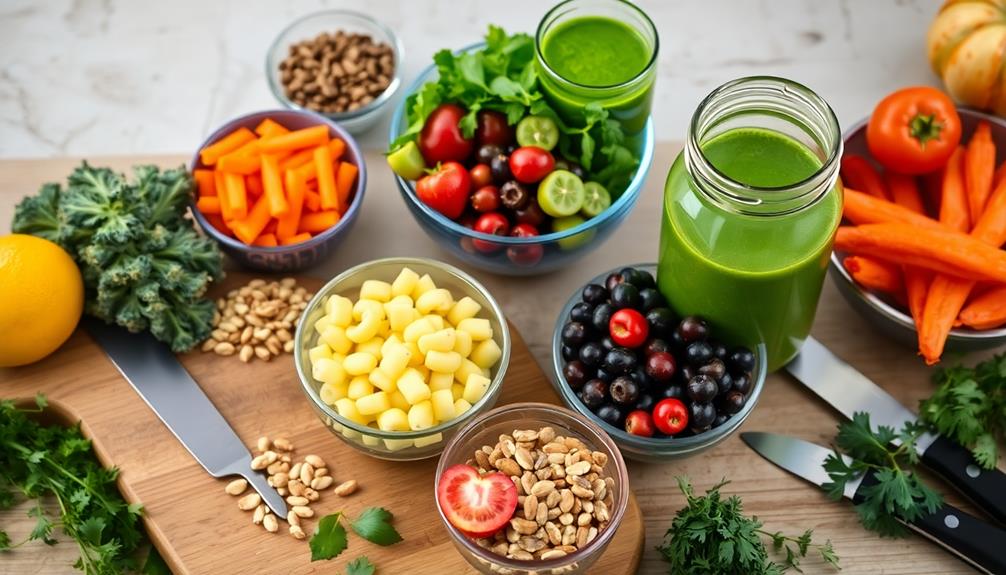
When you immerse yourself in engaging with raw food recipes, you'll discover just how quick and enjoyable they can be.
With an average prep time of just 10 minutes, these vegan dishes fit seamlessly into your busy lifestyle while offering a balanced nutritional intake—each serving typically contains about 350 calories.
Exploring raw food recipes encourages you to play with different flavors and textures.
Here are some delightful ways to enhance your meals:
- Create vibrant salads featuring fresh basil and seasonal ingredients.
- Whip up dips or spreads that serve as perfect side dishes for gatherings.
- Experiment with main dishes that surprise and satisfy.
Frequently Asked Questions
Can You Lose Weight on a Raw Food Diet?
Yes, you can lose weight on a raw food diet. By focusing on high-water, high-fiber fruits and vegetables, you'll naturally consume fewer calories while feeling full, promoting weight loss and healthier eating habits.
What Is the 80 20 Raw Diet?
The 80/20 raw diet lets you enjoy 80% raw foods while allowing 20% cooked options. This balance promotes better nutrition, making it easier for you to shift to healthier eating without feeling deprived or overwhelmed.
How Do I Meal Prep a Week in Advance?
Did you know 60% of people find meal prepping saves them time? To prep a week in advance, choose recipes, bulk prep ingredients, store them in airtight containers, and label for freshness. Enjoy your week!
Is the Raw Food Diet Easy to Follow?
Yes, the raw food diet's easy to follow. You'll find quick recipes, minimal prep time, and plenty of fresh ingredients. Plus, it helps reduce food waste while keeping your meals varied and enjoyable.
Conclusion
In your journey toward vibrant health, raw food meal prep can be a transformative treat! By incorporating easy recipes and crucial ingredients, you'll savor scrumptious, fresh flavors all week long. Remember, with a pinch of planning and a dash of dedication, you can create colorful, nourishing meals that delight your taste buds and boost your well-being. So immerse yourself in the delicious world of raw foods and discover the joy of joyful, healthy eating!

